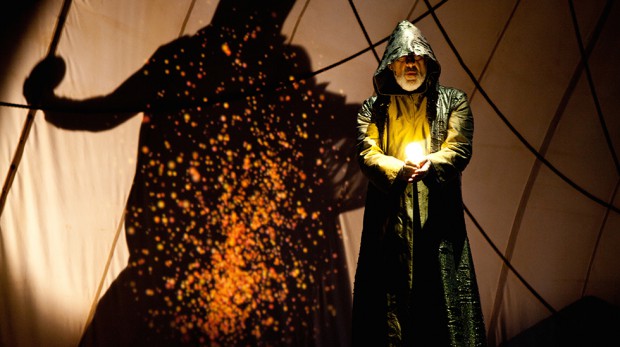
Aboriginal stories are taking over Perth theatre at the moment; the Blue Room and TEEM Productions just wrapped up What Do They Call Me? and Yirra Yaakin is currently running King Hit at the State Theatre Centre. Now Big hART brings their major theatre work, Hipbone Sticking Out, to Perth as it tours the country. The production is part of Big hART’s Yijala Yala Project, which focuses on the community of Roebourne in the Pilbara, working with community members to create artworks that highlight and promote its culture and history.
Hipbone Sticking Out tells the harrowing story of a young Roebourne man who, during a run-in with the police, hits his head on the pavement and subsequently experiences a journey through time, witnessing the trajectory of European influence on the world and in the Pilbara region of Australia. More specifically, it delves into the story of the Flying Foam Massacres, which was a state-sanctioned culling of the Jaburara people on the Burrup Peninsula in 1868.
This event that has not been written into history books, as we learn from two of the cast members of Hipbone¸ Sheridan Harbridge and Michael Whalley. “I was shocked that I had never heard of it, that it wasn’t something that was readily discussed as our history,” says Harbridge. Whalley, who plays multiple cast and chorus roles in the production, is originally from New Zealand, and therefore also felt woefully unaware of the history in the Pilbara region. But he said that one of the best things about being involved in this production has been “…being taken into a different part of the world than I’ve ever been introduced to before, going into the heart of Roebourne, which is a climate and a community that I’ve never been part of, finding out a story that I’ve never heard before and working with members of the community to create a story that is very important for loads of people to hear.”
Harbridge and Whalley are playing several European characters through the course of the show, from settlers in the 1820s to their modern equivalents in the ’80s as part of the Royal Commission into the death of Aboriginal people in custody. They explain that one of the major challenges of working on this show is not to take on the guilt that’s inherent in representing perpetrators of such major human injustice.
Harbridge says, “While Mike’s characters represent the men who did it, my characters represent the women who justify it by saying ‘you were just doing what you were told.’ It’s been tough but also really rewarding to meet this beautiful community.” Whalley adds, “It’s important to take responsibility for the story that we’re telling, to take ownership of something that’s very important for us to tell as part of our European history as well.” They both emphasize that this work is about Australians of all races coming to terms with our history, and that this is not just an Aboriginal story, but our story.”
The company brought the show back to the area of its own genesis, performing at the Roebourne prison; Harbridge expresses how confronting it felt to stand up in front of the Roebourne community. “You never get to rehearse a show in the place where it sprung from. It’s been much more raw to sit in the reality of it and to see what happened 150 years ago,” says Harbridge. “For me one of the incredible moments has been the members of the Roebourne community standing up and letting us know why they invited Big hART there in the first place, and speaking about the direct positive effect it’s had on their lives and their kids’ lives over the last four years. There are lots of reasons you make theatre, but to be involved with a work that is actually directly moving and changing lives is kind of rare. I feel like I’m part of something really important, something that’s not going to be forgotten, and has changed the course of the young people’s lives in Roebourne.”
The version of the show that is currently touring has changed slightly from the original version. Harbridge says, “It’s a really tightened version, because the story is so large with the history of the colonists in the Pilbara, and a lot of it is dark. This version gives the audience a couple more breaths to take stuff in. Some of it gets harrowing, but with this version, Scott Rankin (the writer) gives people time to digest what’s happening, because it’s really epic-style theatre, with music and movement. He’s sort of condensed it and given it a bit more space.”
Harbridge and Whalley want to make sure audiences are aware that although the story the ensemble is telling can be very confronting, there is a lot of humour and lightness to it as well. The show is full of music, with the cast singing entirely a cappella throughout. There is also dance and audio-visual elements, which Harbridge says she has yet to see; she jokes that they’ll have to get on stage and turn around to see what’s going on behind them.
CICELY BINFORD
Hipbone Sticking Out runs until October 4 at the State Theatre Centre. For tickets and session times, go to statetheatrecentrewa.com.au.